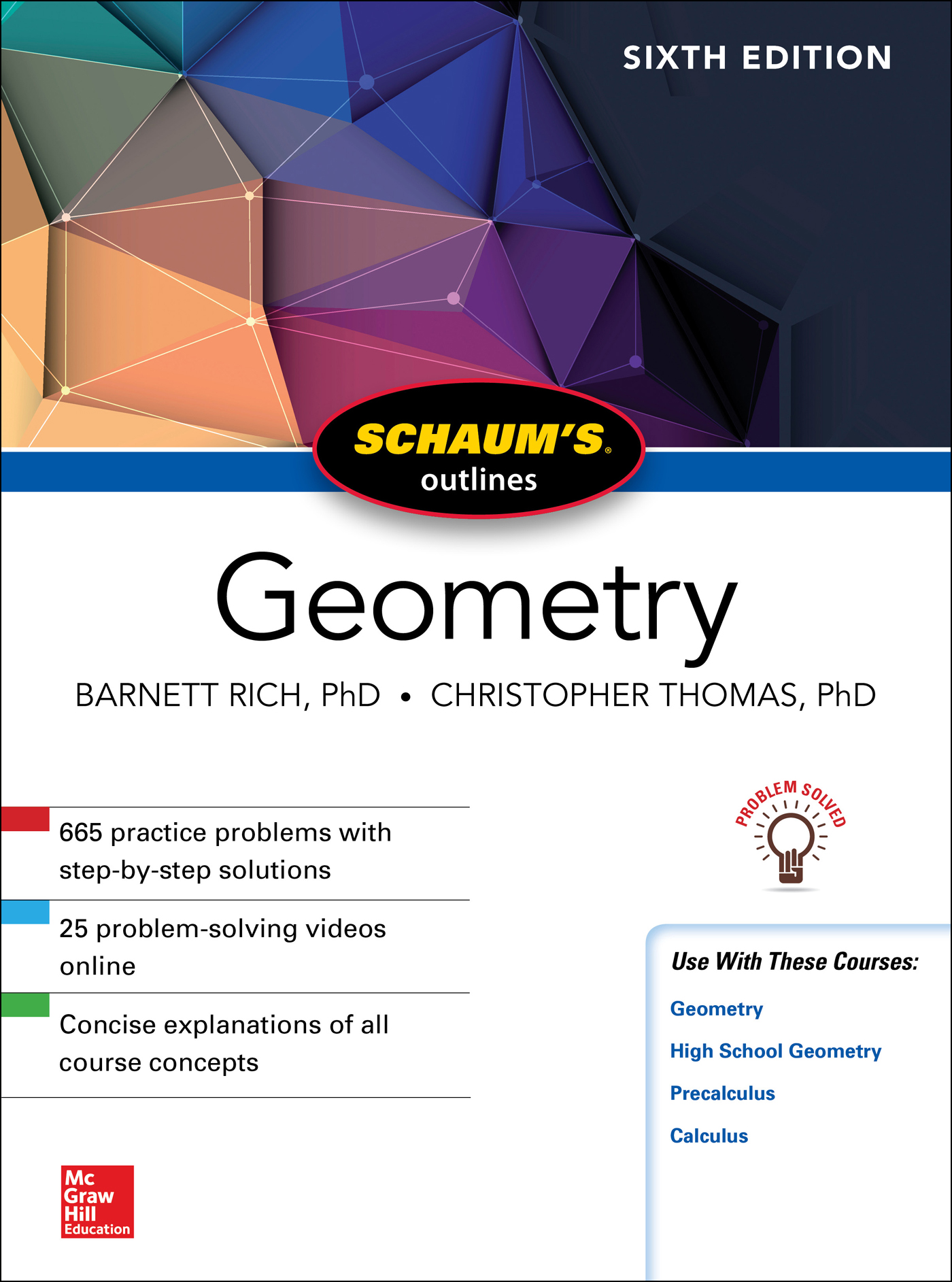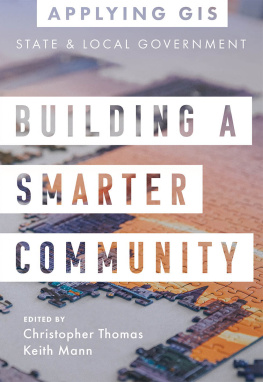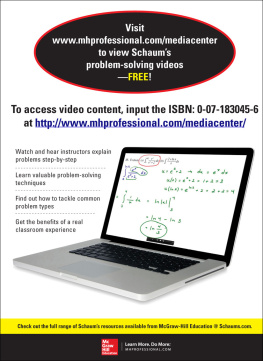Contents
Guide
Page List

Copyright 2018 by McGraw-Hill Education. Except as permitted under the United States Copyright Act of 1976, no part of this publication may be reproduced or distributed in any form or by any means, or stored in a database or retrieval system, without the prior written permission of the publisher. ISBN: 978-1-26-001058-9
MHID: 1-26-001058-9. The material in this eBook also appears in the print version of this title: ISBN: 978-1-26-001057-2,
MHID: 1-26-001057-0. eBook conversion by codeMantra
Version 1.0 All trademarks are trademarks of their respective owners. Rather than put a trademark symbol after every occurrence of a trademarked name, we use names in an editorial fashion only, and to the benefit of the trademark owner, with no intention of infringement of the trademark.
Where such designations appear in this book, they have been printed with initial caps. McGraw-Hill Education eBooks are available at special quantity discounts to use as premiums and sales promotions or for use in corporate training programs. To contact a representative, please visit the Contact Us page at www.mhprofessional.com. BARNETT RICH held a doctor of philosophy degree (PhD) from Columbia University and a doctor of jurisprudence (JD) from New York University. He began his professional career at Townsend Harris Hall High School of New York City and was one of the prominent organizers of the High School of Music and Art where he served as the Administrative Assistant. Later he taught at CUNY and Columbia University and held the post of chairman of mathematics at Brooklyn Technical High School for 14 years.
Among his many achievements are the 6 degrees that he earned and the 23 books that he wrote, among them Schaums Outlines of Elementary Algebra, Modern Elementary Algebra, and Review of Elementary Algebra. CHRISTOPHER THOMAS has a BS from University of Massachusetts at Amherst and a PhD from Tufts University, both in mathematics. He first taught as a Peace Corps volunteer at the Mozano Senior Secondary School in Ghana. Since then he has taught at Tufts University, Texas A&M University, and the Massachusetts College of Liberal Arts. He has written Schaums Outline of Math for the Liberal Arts as well as other books on calculus and trigonometry. TERMS OF USE This is a copyrighted work and McGraw-Hill Education and its licensors reserve all rights in and to the work.
Use of this work is subject to these terms. Except as permitted under the Copyright Act of 1976 and the right to store and retrieve one copy of the work, you may not decompile, disassemble, reverse engineer, reproduce, modify, create derivative works based upon, transmit, distribute, disseminate, sell, publish or sublicense the work or any part of it without McGraw-Hill Educations prior consent. You may use the work for your own noncommercial and personal use; any other use of the work is strictly prohibited. Your right to use the work may be terminated if you fail to comply with these terms. THE WORK IS PROVIDED AS IS. McGRAW-HILL EDUCATION AND ITS LICENSORS MAKE NO GUARANTEES OR WARRANTIES AS TO THE ACCURACY, ADEQUACY OR COMPLETENESS OF OR RESULTS TO BE OBTAINED FROM USING THE WORK, INCLUDING ANY INFORMATION THAT CAN BE ACCESSED THROUGH THE WORK VIA HYPERLINK OR OTHERWISE, AND EXPRESSLY DISCLAIM ANY WARRANTY, EXPRESS OR IMPLIED, INCLUDING BUT NOT LIMITED TO IMPLIED WARRANTIES OF MERCHANTABILITY OR FITNESS FOR A PARTICULAR PURPOSE.
McGraw-Hill Education and its licensors do not warrant or guarantee that the functions contained in the work will meet your requirements or that its operation will be uninterrupted or error free. Neither McGraw-Hill Education nor its licensors shall be liable to you or anyone else for any inaccuracy, error or omission, regardless of cause, in the work or for any damages resulting therefrom. McGraw-Hill Education has no responsibility for the content of any information accessed through the work. Under no circumstances shall McGraw-Hill Education and/or its licensors be liable for any indirect, incidental, special, punitive, consequential or similar damages that result from the use of or inability to use the work, even if any of them has been advised of the possibility of such damages. This limitation of liability shall apply to any claim or cause whatsoever whether such claim or cause arises in contract, tort or otherwise.
Providing Help for the Student
This book has been designed to improve the learning of geometry far beyond that of the typical and traditional book in the subject.
Providing Help for the Student
This book has been designed to improve the learning of geometry far beyond that of the typical and traditional book in the subject.
Students will find this text useful for these reasons: (1) Learning Each Rule, Formula, and Principle Each rule, formula, and principle is stated in simple language, is made to stand out in distinctive type, is kept together with those related to it, and is clearly illustrated by examples. (2) Learning Each Set of Solved Problems Each set of solved problems is used to clarify and apply the more important rules and principles. The character of each set is indicated by a title. (3) Learning Each Set of Supplementary Problems Each set of supplementary problems provides further application of rules and principles. A guide number for each set refers the student to the set of related solved problems. There are more than 2000 additional related supplementary problems.
Answers for the supplementary problems have been placed in the back of the book. (4) Integrating the Learning of Plane Geometry The book integrates plane geometry with arithmetic, algebra, numerical trigonometry, analytic geometry, and simple logic. To carry out this integration: (a) A separate chapter is devoted to analytic geometry. (b) A separate chapter includes the complete proofs of the most important theorems together with the plan for each. (c) A separate chapter fully explains 23 basic geometric constructions. (d) Two separate chapters on methods of proof and improvement of reasoning present the simple and basic ideas of formal logic suitable for students at this stage. (e) Throughout the book, algebra is emphasized as the major means of solving geometric problems through algebraic symbolism, algebraic equations, and algebraic proof. (5) Learning Geometry Through Self-study The method of presentation in the book makes it ideal as a means of self-study. (5) Learning Geometry Through Self-study The method of presentation in the book makes it ideal as a means of self-study.
For able students, this book will enable then to accomplish the work of the standard course of study in much less time. For the less able, the presentation of numerous illustrations and solutions provides the help needed to remedy weaknesses and overcome difficulties, and in this way keep up with the class and at the same time gain a measure of confidence and security. (6) Extending Plane Geometry into Solid Geometry A separate chapter is devoted to the extension of two-dimensional plane geometry into three-dimensional solid geometry. It is especially important in this day and age that the student understand how the basic ideas of space are outgrowths of principles learned in plane geometry.






